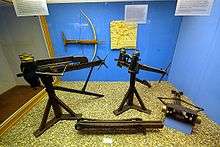Onager (weapon)

 |
| Part of a series on the |
| Military of ancient Rome |
|---|
|
|
The onager (British /ˈɒnədʒə/, /ˈɒnəɡə/, U.S. /ˈɑnədʒər/[1]) was an imperial-era Roman torsion powered siege engine; in other words, a small catapult. The onager was first mentioned in 353 AD by Ammianus Marcellinus, who described onagers as the same as a scorpion.
Etymology
According to two authors of the later Roman Empire who wrote on military affairs, the onager derived its name from the kicking action of the machine that threw stones into the air, as did the hooves of the wild ass, the onager, which was native to the eastern part of the empire.[2]
Design
The onager consisted of a large frame placed on the ground to whose front end a vertical frame of solid timber was rigidly fixed. A vertical spoke that passed through a rope bundle fastened to the frame had a sling attached which contained a projectile. To fire it, the spoke or arm was forced down, against the tension of twisted ropes or other springs, by a windlass, and then suddenly released. As the sling swung outwards, one end would release, as with a staff-sling, and the projectile would be hurled forward. The arm would then be caught by a padded beam or bed, when it could be winched back again.[3]
The onagers of the Roman Empire were mainly used for besieging forts or settlements. They would often be armed with large stones that could be covered with a combustible substance and set alight.
History
The onager was used from the 4th century AD until the 6th century AD. The late-fourth century author Ammianus Marcellinus describes 'onager' as a neologism for scorpions and relates various incidents in which the engines fire both rocks and arrow-shaped missiles.[4] The late-fourth or early-fifth century military writer Vegetius stipulates that a legion ought to field ten onagers, one for each cohort. These he says should be transported fully assembled on ox carts to ensure readiness in case of sudden attack, in which case the onagers could be used for defence immediately. For Vegetius, the onagers were stone throwing machines.[5]
In the late 6th century the Avars brought the Chinese traction trebuchet, otherwise known as the mangonel, to the Mediterranean, where it soon replaced the slower and more complex torsion powered engines.[6]
The traction trebuchet displaced classical, torsion-powered artillery because it was simpler and required less competence to build, while maintaining comparable range and power, and it had far higher rates of firing and accuracy (when operated by a trained crew). Furthermore, it was probably safer to operate than tension weapons, whose bundles of taut sinews stored up huge amounts of energy even in resting state and were prone to catastrophic failure when in use.[7]
— Inge Ree Peterson
See also
References
- ↑ Oxford English Dictionary.
- ↑ Vegetius, De re militari, IV:22; Ammianus Marcellinus, Roman History XXIII:4, 4; XXXI:15, 12.
- ↑ Denny, Mark "The Physics Teacher" vol 47, p 574-578, December 2009
- ↑ Ammianus Marcellinus, Roman History, XIX:2 & 7; XX:7; XXIII:4; XXIV: 4; XXXI:15.
- ↑ Vegetius, De re militari, IV:22
- ↑ Purton 2009, p. 364.
- ↑ Peterson 2013, p. 409.
Bibliography
- Peterson, Leif Inge Ree (2013), Siege Warfare and Military Organization in the Successor States, Brill
- Purton, Peter (2009), A History of the Early Medieval Siege c.450-1200, The Boydell Press
